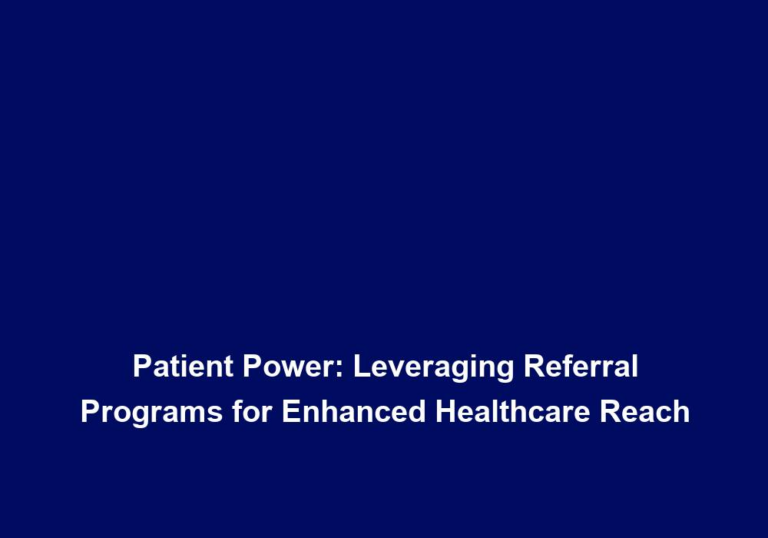Multiply Your Reach: Mastering Patient Referral Programs in Healthcare
In the ever-evolving landscape of healthcare, patient referral programs have emerged as a powerful tool to expand your reach and increase your patient base. By effectively implementing and mastering these programs, healthcare providers can tap into a network of satisfied patients who, in turn, become brand advocates and refer new patients to their practice. In this article, we will explore the intricacies of patient referral programs and provide you with actionable strategies to maximize their effectiveness.
Why Patient Referral Programs Matter
Patient referral programs hold immense value for healthcare providers for several reasons. Firstly, they offer a cost-effective way to acquire new patients. Traditional marketing methods can be expensive and may not always yield satisfactory results. On the other hand, patient referral programs leverage the trust and credibility of existing patients to attract new ones, often at a fraction of the cost.
Secondly, patient referrals have a higher chance of converting into loyal patients. When a friend, family member, or colleague recommends a healthcare provider, it carries significant weight. The trust established through a personal connection can greatly influence a potential patient’s decision to choose your practice over competitors.
Lastly, patient referrals contribute to the overall growth and success of a healthcare practice. By consistently attracting new patients through referrals, providers can build a robust patient base and enhance their reputation within the community. This can lead to increased revenue, better brand recognition, and improved patient satisfaction.
Key Elements of an Effective Patient Referral Program
To establish a successful patient referral program, certain key elements must be incorporated. These include:
Clear Referral Guidelines
Clearly defining the guidelines for patient referrals is crucial to ensure consistency and avoid confusion. Create a set of simple and easy-to-understand rules that outline the eligibility criteria and the rewards associated with referrals. Consider factors such as the type of referral (new patient or existing patient), the specific services offered, and any limitations or restrictions that may apply.
Additional Information:
- Provide examples of eligible referrals to make it easier for patients to understand who they can refer.
- Clearly state the process for submitting referrals, whether it’s through an online form, referral cards, or in-person discussions.
- Specify any timeframes or deadlines for referrals to ensure patients are aware of any limitations.
Incentives and Rewards
Incentives play a pivotal role in motivating patients to participate actively in a referral program. Offering attractive rewards, such as discounts on services, free consultations, or exclusive access to special events, can significantly increase patient engagement. Additionally, consider implementing a tiered reward system, where patients receive greater incentives for referring multiple individuals.
Additional Information:
- Clearly communicate the incentives and rewards to patients, highlighting the value they will receive for their referrals.
- Provide a variety of incentives to cater to different patient preferences and interests.
- Consider partnering with local businesses to offer joint incentives, such as discounts on complementary services or products.
Streamlined Tracking and Reporting
Efficient tracking and reporting mechanisms are essential to monitor the success of your referral program. Utilize technology solutions, such as CRM (Customer Relationship Management) software or dedicated referral management systems, to track referrals from start to finish. This enables you to measure the effectiveness of your program, identify top referrers, and make informed decisions for program optimization.
Additional Information:
- Use unique referral codes or links to track referrals accurately and attribute them to specific patients.
- Regularly review referral data to identify trends, such as the most successful referral sources or the most effective communication channels.
- Consider automating the tracking and reporting process to streamline operations and reduce administrative burden.
Communication and Promotion
To ensure the success of your patient referral program, effective communication and promotion are vital. Regularly inform your existing patients about the program through various channels, such as email newsletters, social media posts, or in-person conversations. Emphasize the benefits of participation and make it easy for patients to refer others by providing referral cards or online referral forms.
Additional Information:
- Develop a comprehensive communication plan to reach patients consistently and keep them informed about the referral program.
- Leverage social media platforms to share success stories of patients who have benefited from the program.
- Provide clear instructions on how patients can refer others, including step-by-step guides or video tutorials.
Follow-Up and Recognition
Appreciating and acknowledging your patients’ efforts in referring others is crucial for program sustainability. Implement a robust follow-up system to thank referrers promptly and recognize their contributions publicly. This can be in the form of personalized thank-you notes, public shout-outs on social media, or even small tokens of appreciation. By doing so, you not only encourage continued participation but also reinforce positive patient-provider relationships.
Additional Information:
- Create a system for tracking and monitoring referrals to ensure no referrer goes unnoticed or unappreciated.
- Consider hosting referral appreciation events or creating a referral “hall of fame” to publicly recognize top referrers.
- Encourage patients to share their referral success stories with others, showcasing the impact of their referrals.
Strategies for Maximizing the Effectiveness of Patient Referral Programs
While implementing the key elements discussed above is essential, certain strategies can further enhance the effectiveness of your patient referral program. Consider the following approaches:
Targeted Outreach Campaigns
Identify specific segments of your patient base that may have a higher propensity to refer others. For instance, patients who have had exceptional experiences, those who have been with your practice for an extended period, or those who have referred others in the past. Design targeted outreach campaigns to engage these individuals and incentivize them to continue referring new patients.
Additional Information:
- Conduct patient surveys or feedback sessions to identify patients who are most likely to refer others.
- Develop personalized messaging and offers tailored to each segment’s interests and needs.
- Provide ongoing support and resources to these segments to encourage their continued participation.
Collaborate with Local Businesses and Organizations
Forge partnerships with local businesses, community organizations, or other healthcare providers to expand your referral network. Establish mutually beneficial arrangements where you refer patients to their services, and they reciprocate by referring patients to your practice. This cross-referral strategy not only widens your reach but also strengthens your presence within the community.
Additional Information:
- Research local businesses and organizations that align with your practice’s values and target audience.
- Create a referral partnership agreement that outlines the terms and expectations for both parties.
- Regularly communicate and collaborate with your referral partners to maintain strong relationships and maximize referrals.
Leverage Online Platforms and Reviews
In today’s digital age, online platforms and reviews hold immense power. Encourage your satisfied patients to share their positive experiences on popular platforms like Google Reviews, Healthgrades, or Yelp. Positive online reviews serve as a form of referral, attracting new patients who are actively seeking healthcare providers. Additionally, actively engage with patients on social media to foster a sense of community and encourage them to share their experiences with their online networks.
Additional Information:
- Provide patients with easy-to-follow instructions on how to leave online reviews and ratings.
- Monitor online platforms to address any negative reviews or feedback promptly.
- Engage with patients on social media by responding to comments, sharing educational content, and highlighting patient success stories.
Continuously Monitor and Optimize
Regularly review and analyze the performance of your patient referral program to identify areas for improvement. Monitor metrics such as referral conversion rates, referral sources, and overall program ROI. Based on these insights, make necessary adjustments to your program, such as modifying incentives, optimizing communication channels, or refining your targeting strategies. By continuously monitoring and optimizing your program, you ensure its long-term success.
Additional Information:
- Use analytics tools to track and measure program performance, including referral conversion rates and ROI.
- Seek feedback from patients and referral sources to gather insights on program effectiveness and areas for improvement.
- Stay updated with industry trends and best practices to incorporate new strategies into your referral program.
Conclusion
Patient referral programs present a significant opportunity for healthcare providers to multiply their reach and attract new patients. By incorporating the key elements discussed and implementing effective strategies, you can master the art of patient referral programs in healthcare. Remember, a satisfied patient can be your most influential brand ambassador, and by leveraging their trust and loyalty, you can fuel the growth and success of your practice.







